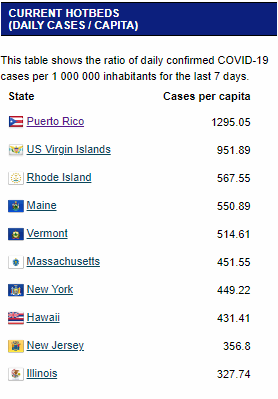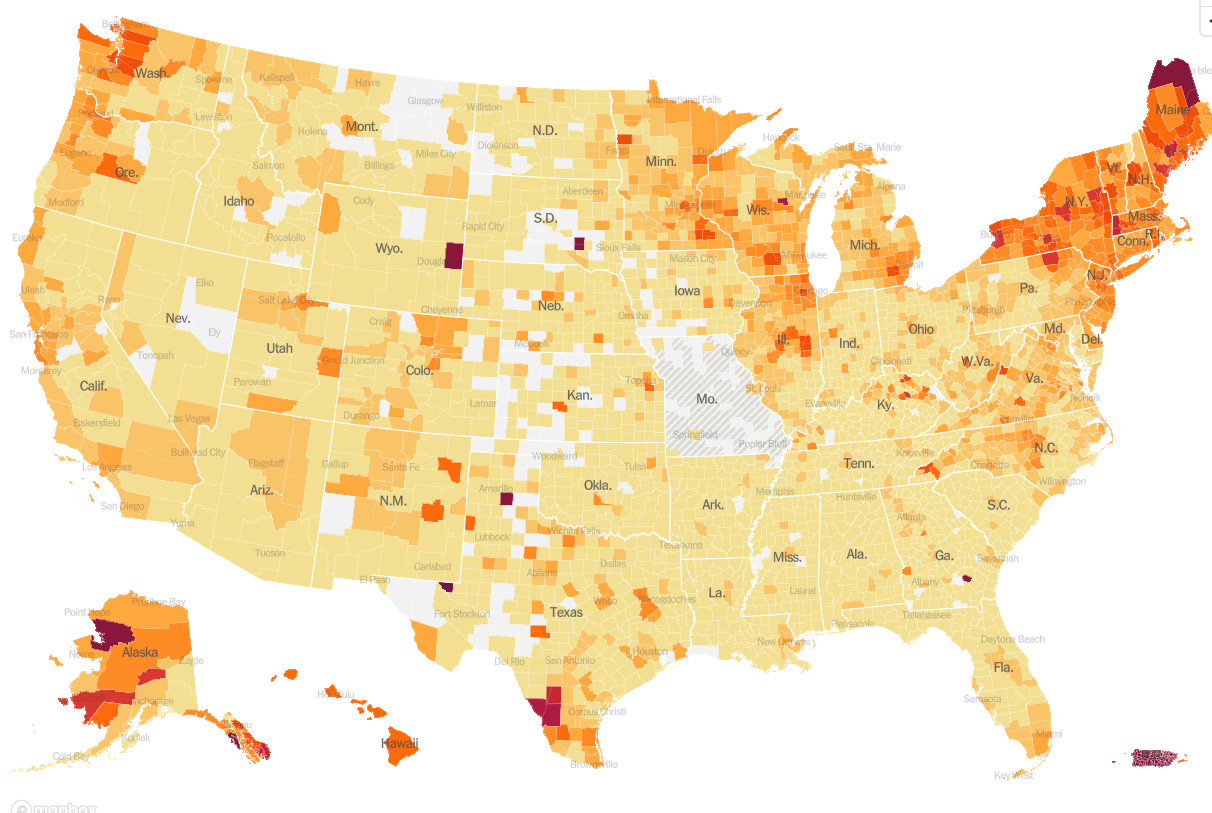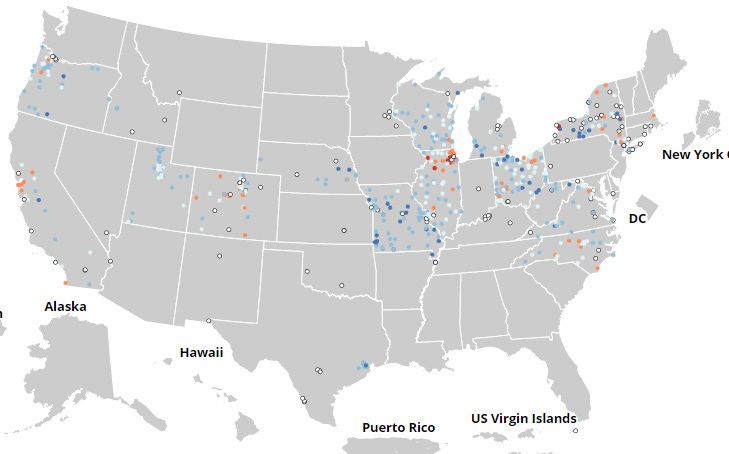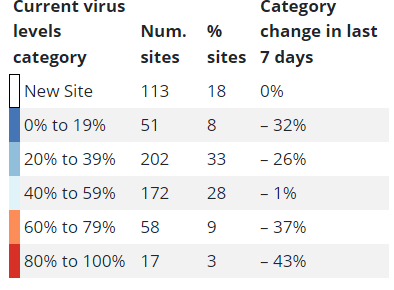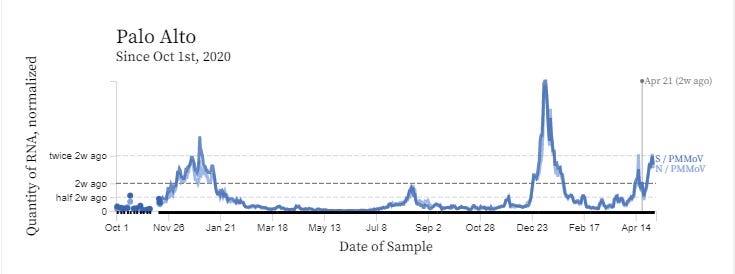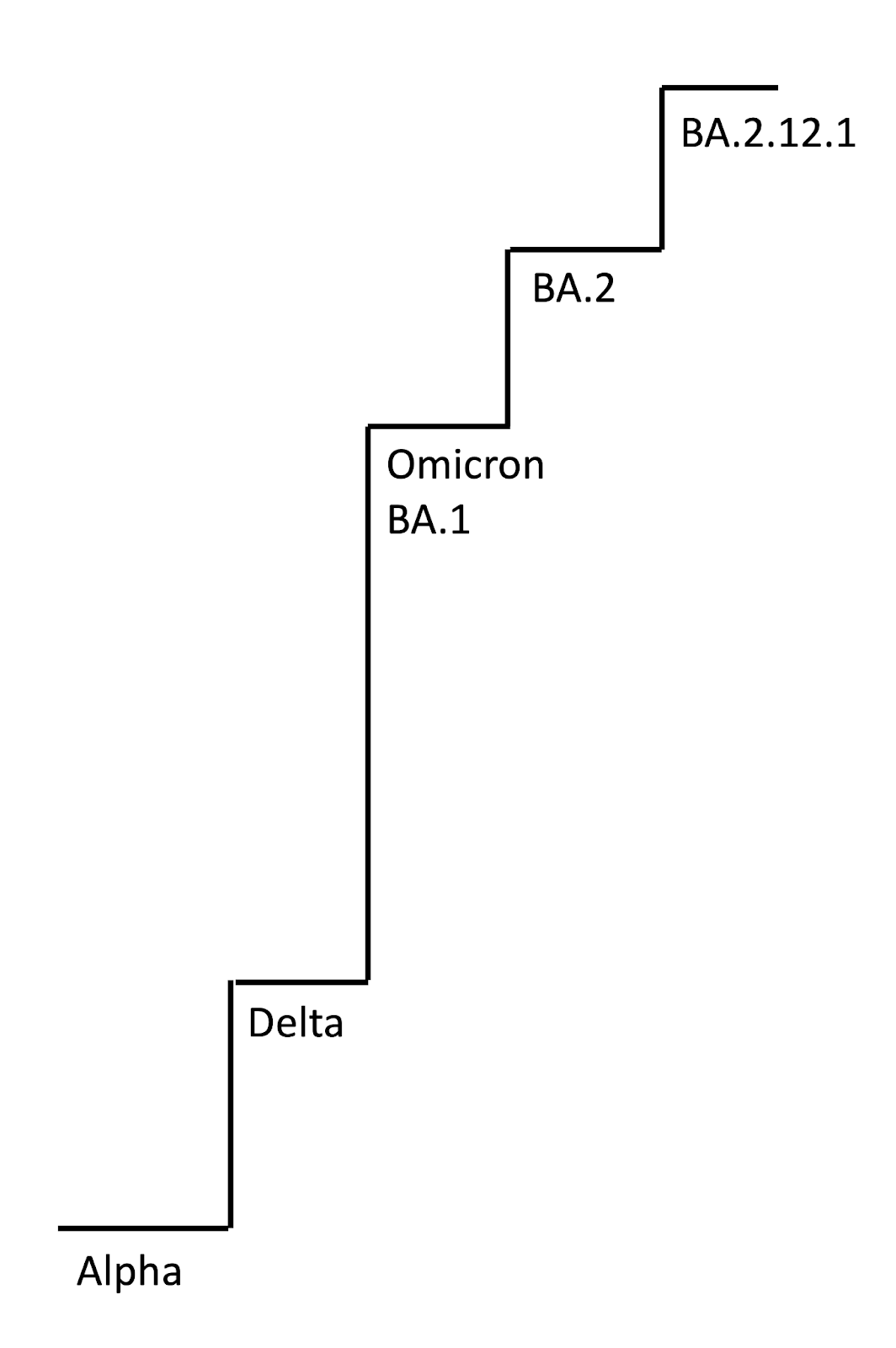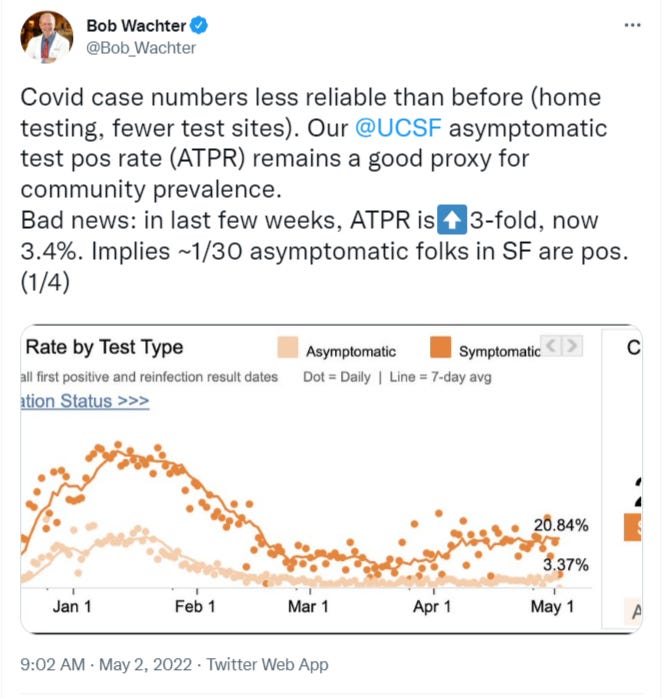COVID news 5/6/22
Hi all,
There is lots of info on the newer Omicron variants this week:
New data shows that BA.2.12.1 (which I am calling "BA2121" because it is easier to say) will soon become dominant in the U.S. as it has in NY state and the northeast.
The newer Omicron variants (BA.2, BA2121, BA.4/BA.5) are more infectious than BA.1.
BA2121 has a 25% increase in transmissibility over BA.2 which was 30% more transmissible than Omicron BA.1 which was 3x more transmissible than Delta.
BA2121, BA.4/BA.5 have more immune escape (meaning antibodies don't work as well against them).
Because of the increased immune escape by the new variants, people who had Omicron BA.1 infections (40% of Americans) may become reinfected by BA2121 in the US (and by BA.4 and BA.5 in South Africa) especially if they were not vaccinated.
So far, severity of infections seems about the same for all Omicron variants.
BA2121 and BA.4/BA.5 are also resistant to many monoclonal antibodies including some in Evusheld.
BA.2 was resistant to the monoclonal antibody Sotrovimab, so its EUA from the FDA was revoked last week. But, BA2121 and BA.4/BA.5 are more susceptible to the Sotrovimab monoclonal antibody so we may see it coming back as a treatment.
In triple vaccinated (3 doses) people in the UK, about 8% of breakthrough infections with Omicron BA.1 and Delta cause Long COVID, but BA.2's risk of Long COVID is slightly higher with 9.3% Long COVID prevalence vs 7.8% for for BA.1.
Are you totally confused yet? Eric Topol MD has made this helpful table on the new Omicron variants.
A sad statistic from this week is that the United States has surpassed 1 million deaths related to SARS-CoV-2. The WHO also stated that the excess death rate for COVID worldwide is closer to 15 million instead of the 5 million that has been reported.
Masks have come off and people are taking less precautions now which is the perfect storm for the newer, more contagious and more immune evasive variants. Bob Wachter MD shows statistics that about every 1 in 30 people in San Francisco have asymptomatic COVID now, so larger events and indoor spaces that hold more people will increase a person's risk of coming in contact with a person with asymptomatic COVID. People who are asymptomatic have just as high viral loads and are just as contagious as those with symptomatic COVID.
Many more home antigen tests are being used now and positive results are not usually reported to the public health departments. A new website called OutbreaksNearMe.org allows people to post their positive or negative home tests but I think that its use is spotty. Therefore, wastewater surveillance seems like a better way to track cases. The CDC's wastewater page is difficult to read, so it may be easier to go directly to your state or county's wastewater website for insight. Here in the Bay Area, we are seeing a rise in BA.2 virus in the wastewater in Santa Clara and San Mateo counties. Vaccinations and boosters help prevent hospitalizations, so remember to get your booster(s) if you haven't already.
Take care,
Ruth Ann Crystal MD
Twitter: https://twitter.com/CatchTheBaby
COVID news:
World
United States
5/5/22
Local wastewater:
https://covid.cdc.gov/covid-data-tracker/#wastewater-surveillance
City of Palo Alto newsletter: While BA.2 remains the prevalent Omicron variant in the western United States, coronavirus cases have increased nearly 30% in California and 103% in Santa Clara County as of May 4 compared to the average count on April 20, two weeks ago.
5/6/22 UK Office for National Statistics (ONS): Self-reported Long COVID after breakthrough infection with the Omicron variant in the UK https://buff.ly/3yoFReO
2 doses vaccine, at 4 to 8 weeks after breakthrough infection:
50% Less Long COVID with Omicron BA.1 than Delta in double vaccinated people.
16% had Long COVID after Delta and 8.7% after Omicron BA.1 infection.
3 doses vaccine (triple vaccinated) with breakthrough infection:
BA.1: No difference in Long COVID after Delta (8.5%) or BA.1 (8.0%).
BA.2: self-reported long COVID was 7.4% for Delta and 9.1% for BA.2.
Compared to BA.1 infection, BA.2 breakthrough infection was 21.8% higher among adults who were triple-vaccinated when infected
3 dose adjusted Long COVID prevalence was higher for infections with Omicron BA.2 (9.3%) than it was for BA.1 (7.8%).
5/6/22 5/6/22 Lancet: Long Covid: A Systematic Review and Meta-Analysis of 120,970 Patients https://buff.ly/39Ku9kv
A systematic Long Covid review of nearly 200 studies and over 120,000 participants, reinforces the high frequency of symptoms > 6 months, not linked to severity of acute illness, and potential for marked disability.
The incidence of any long COVID symptomatology was 56.9%. The incidence of long COVID symptomatology was different according to continent, age and follow-up length.
5/5/22 It Ain’t Over ’Til It’s Over https://buff.ly/3vKVfR5
Science, Editorial by H. Holden Thorp
"Add to this mounting inflation worries and concerns about the war in Ukraine, and the response has been a clumsy pivot to a message that politicians always turn to: personal responsibility.
Get vaccinated, get boosted, wear a mask, get a prescription for the antiviral Paxlovid—if you want to.
This may be fine if you have a healthy immune system, great health insurance, and the ability to navigate the US healthcare system. But what about everyone else?”
5/5/22 FDA Updates on Paxlovid for Health Care Providers https://buff.ly/3vMS6QB
In non-hospitalized patients at high risk of progression to severe disease, Paxlovid reduced the risk of hospitalization or death by 88%.
In the Paxlovid clinical trial, some patients (range 1-2%) had one or more positive SARS-CoV-2 PCR tests after testing negative, or an increase in the amount of SARS-CoV-2 detected by PCR, after completing their treatment course.
This finding was observed in patients treated with the drug as well as patients who received placebo.
There was no increased hospitalization or death or drug resistance in these patients with rebound positive tests.
5/5/22 KFF: 1 in 5 Parents of Children Under Age 5 Intend to Get Them a COVID-19 Vaccine Right Away Once Eligible https://buff.ly/3sfqvW4
Parents of under age 5 kids:
18% will get right away
38% will wait and see how other kids do
11% will get only if required
27% will definitely not vaccinate
5/5/22 STATnews: FDA limits use of Johnson & Johnson's Covid-19 vaccine, citing clotting risk https://buff.ly/3L2veRP
5/4/22 SF Chronicle: The next COVID surge may hit San Francisco’s wealthy neighborhoods the hardest. Here’s why https://buff.ly/3kZz8jP
Nobody knows for sure.
As compared to lower income neighborhoods, SF’s wealthier neighborhoods’ higher case rates are being driven by two factors:
Increased exposure (wealthy people are taking fewer precautions than in the beginning of the pandemic, and are getting exposed to COVID more often.)
Less “natural” immunity (lower income people often worked essential jobs earlier in the pandemic and got COVID in the past waves.)
5/5/22 BBC: Covid: World’s true pandemic death toll nearly 15 million, says WHO https://buff.ly/3vMx6te
5/5/22 LA Times: L.A. County workplaces and schools seeing rising coronavirus cases https://buff.ly/3siqPU5
L.A. County is now tallying 157 cases a week for every 100,000 residents. Anything 100 or higher is considered a high rate of transmission, according to the CDC.
In schools, cases are increasing but much more gradually than they did during the last wave in December.
L.A. County wastewater virus levels are stable, and the test positivity rate is just above 2%. COVID-19 is not putting pressure on our healthcare system at this time.
The U.S. federal government has run out of money to fund tests and vaccinations for uninsured people which affects Los Angeles county.
5/4/22 BA.2.12.1, BA.4 and BA.5 escape antibodies elicited by Omicron (BA.1) infection https://buff.ly/3vFLCTE
BA.2.12.1 and BA.4, BA.5 displayed stronger humoral immunity evasion capability than BA.2, revealed by neutralization assays using the plasma of 3-dose vaccinees and vaccinated BA.1 convalescents.
5/4/22 BioRxiV: Sensitivity of novel SARS-CoV-2 Omicron subvariants, BA.2.11, BA.2.12.1, BA.4 and BA.5 to therapeutic monoclonal antibodies https://buff.ly/3kDURNS
Pseudoviruses of Omicron subvariants and derivatives were tested using eight therapeutic monoclonal antibodies.
Consistent with previous studies, bamlanivimab, casirivimab, etesevimab, imdevimab and tixagevimab were not functional against BA.2.
These five antibodies did not work against new Omicron subvariants, while the BA.2 S bearing R493Q substitution was partially sensitive to casirivimab and tixagevimab.
Interestingly, bebtelovimab was ~2-fold more effective against BA.2 and all Omicron subvariants tested than the parental virus.
Although sotrovimab was ~20-fold less antiviral against BA.2 than the parental virus, the Omicron subvariants bearing L452R substitution including BA.2.11 and BA.4/5 were more sensitive to Sotrovimab than BA.2.
Cilgavimab is antiviral against BA.2.
BA.4/5 exhibits 30x higher resistance to Cilgavimab compared to BA.2.
The L452R/Q substitution rendered ~2-5-fold resistance to Cilgavimab.
Evusheld (PrEP) is a combo of Tixagevimab and Cilgavimab.
5/4/22 BMJ: COVID-19 vaccine wastage in the midst of vaccine inequity: causes, types and practical steps https://buff.ly/37T0MvT
Open and closed vial COVID-19 vaccine wastage has been reported to be as high 30% due to expiration of vaccines and decreased demand, , while in low-income countries only 15% of people have been vaccinated.
5/5/22 Climbing the ladder of infectiousness by Eric Topol MD https://buff.ly/3Fi6Km8
BA.2.12.1 will become dominant in the U.S. as it has in NY state.
BA.2.12.1 has a 25% increase in transmissibility over BA.2 which was 30% more transmissible than Omicron BA.1 which was 3x more transmissible than Delta.
Infectiousness:
People who had Omicron BA.1 infections (40% of Americans) may become reinfected by BA.2.12.1 because of immune escape.
BA2.12.1 and BA.4/BA.5 are resistant to many monoclonal antibodies.
Puerto Rico cases exceed 100 per 100,000 residents, and has some increase in hospitalizations.
In New York State, BA.2.12.1 is dominant now but there has not been a rise in hospitalizations like the OG Omicron BA.1 wave last December through February.
5/3/22 Nature: Alterations in microbiota of patients with COVID-19: potential mechanisms and therapeutic interventions https://buff.ly/3KBgt7Z
In depth review of possible microbiota-based prophylaxes and therapies for COVID-19 and PACS (Long COVID) to modulate host microbiota and mitigate virus-induced inflammation.
Respiratory and gastrointestinal (GI) systems have high amounts of ACE-2 and TMPRSS2 receptors.
Microbiota are significantly altered in patients with COVID-19 and post-acute COVID-19 syndrome (PACS) or Long COVID.
Microbiota-derived metabolites can influence host immunity.
Respiratory and Gastrointestinal (GI) symptoms in SARS-CoV-2 infection
Gut commensal-derived metabolites or components potentially promote lung antiviral immune responses via gut–lung axis during the early stages of SARS-CoV-2 infection:
Anti-inflammatory immunomodulation by gut microbiota-derived metabolites and components:
5/3/22 Nature: Pan-coronavirus vaccine pipeline takes form https://buff.ly/39ys7Uy
Dozens of ‘universal’ coronavirus vaccines are in development. But will new technology platforms be able to overcome immunological unknowns?
Only a few pan-coronavirus vaccines are in some phase of clinical testing but these could help us to be prepared for new variants ahead.
5/3/22 UK
5/2/22 Cell: Virological characteristics of the SARS-CoV-2 Omicron BA.2 spike https://buff.ly/3s9y9RP
BA.2 compared to BA.1:
The effective reproduction number of BA.2 is 1.4-fold higher than that of BA.1
Immune evasion: BA.2 is resistant to BA.1-induced humoral immunity.
The BA.2 spike is more fusogenic than the BA.1 spike and causes syncytia formation.
BA.2 spike-bearing virus is more pathogenic than BA.1 spike-bearing virus in hamsters.
5/2/22 MedRxiV: Protection against Omicron re-infection conferred by prior heterologous SARS-CoV-2 infection, with and without mRNA vaccination https://buff.ly/3LFGK6E
Quebec, Dec 2021 to March 2022 (Omicron), 700,000 cases and controls
The high protection against Omicron infections and hospitalizations afforded by prior Covid infection (non-Omicron), further enhanced with vaccination, and a significant advantage over those without infection history.
mRNA vaccine effectiveness against Omicron infection was consistently significantly higher among previously-infected vs. non-infected individuals:
65% vs. 20% for one-dose
68% vs. 42% for two doses
83% vs. 73% for three doses.
1 in 30 asymptomatic people in San Francisco are now positive for COVID.
5/1/22 Washington Post (paywall): Virus mutations aren’t slowing down. New omicron subvariant proves it. https://buff.ly/3kuruh1
5/2022 Critical Care Explorations J: Neurologic Manifestations of SARS-CoV-2 Infection in Hospitalized Patients During the First Year of the COVID-19 Pandemic https://buff.ly/3KOdhpY
Prospective observational study
Encephalopathy (10.2%) at admission is common in hospitalized patients with SARS-CoV-2 infection and is associated with worse outcomes.
While serious neurologic manifestations including stroke (2.0%), seizure (1.5%), and meningitis/encephalitis (0.5%) were less common, all were associated with increased ICU support utilization, more severe disease, and worse outcomes.




